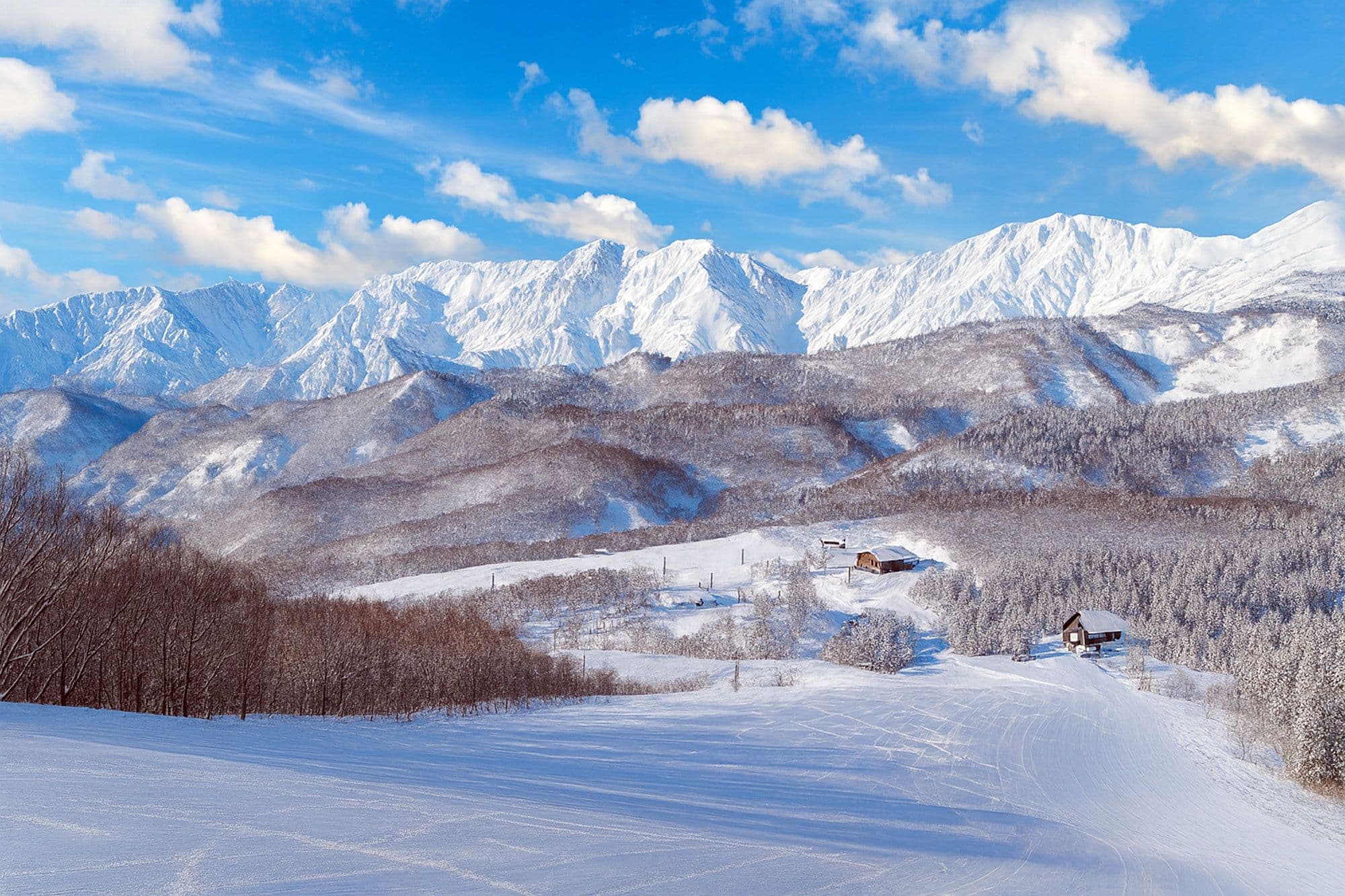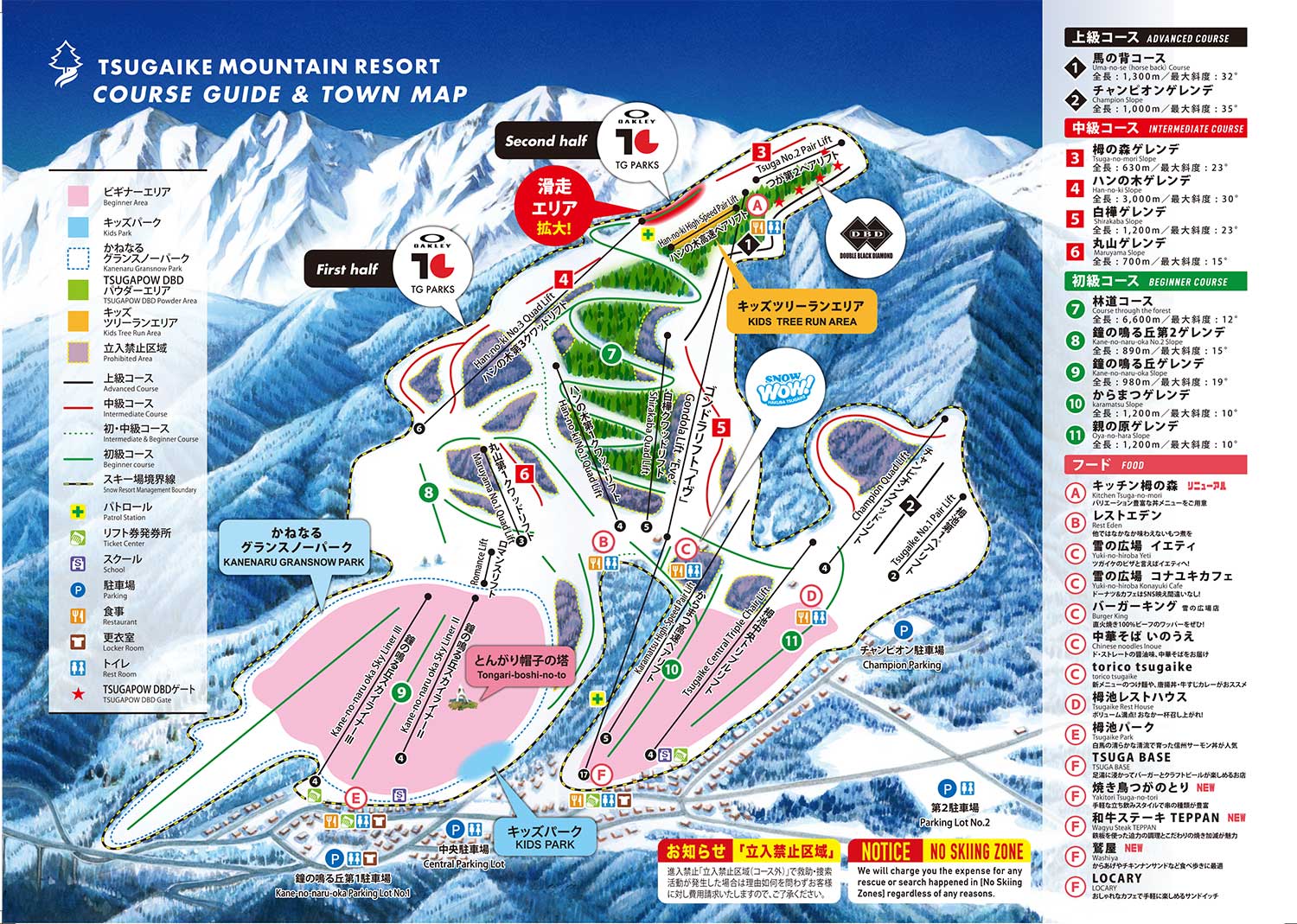Tsugaike Kogen
Wide, forgiving, and quietly deep

栂池高原
Big snowfield energy with a Hakuba twist
Tsugaike is the sleeper of Hakuba Valley — a sprawling, sunken amphitheater of easy-going terrain that funnels up into chilled-out bowls and soft, birch-lined ridges. If Happo is the flashy headliner and Cortina is the storm-day mosh pit, Tsugaike is where you spread out, breathe, and let the skis run. The base is almost comically wide, so families and progressing riders can carve Corduroy for days, while stronger skiers slip higher to chase knee-deep shots between trees when the Sea-of-Japan engine starts puking.
Village life here skews quieter than central Hakuba. The resort straddles Otari’s Tsugaike hamlet, with most lodging and food clustered at the base. English is common around tickets, rentals, and ski school, and you’ll hear plenty of international accents midwinter. Weekdays are mellow; Saturdays see the base area swell with school groups and Tokyo families. The trick is simple — ride high early and drop to the plateau for a lazy, late lunch.
What makes Tsugaike special is proportion. Kane-no-naru-oka, the huge lower “bell-ringing hill,” is a progression playground with natural rollers and a pitch that coaxes confidence. Mid-mountain around Uwanodaira tightens up and tilts gently, then the upper zone — Tsuga-no-mori and Han-no-ki — catches wind buff and frequent resets. On the deepest mornings, the designated trees ride green-room smooth, and the fall line stays friendly even when you’re trenching.
Practicalities are kind. The base has ample parking, multiple rental outlets, lockers, and warm, cavernous rest houses. Night skiing lights a chunk of the lower field for groms and those with gas left in the tank. Apres is low-key — steaming bowls, a beer, then bed — because this is a first-chair kind of mountain when the flakes are stacking sideways.
Resort Stats
- Vertical900m (1700m → 800m)
- Snowfall~10m
- Terrain 50% 30% 20%
- Tree Riding
- Lift Pass$50
- Lifts1 gondola, 5 quads, 10 pair
- Crowds
- Out of Boundsvia gates (registration required)
- Night Skiing
- Family Friendly
- Trails20
- Skiable Area~200ha
- Vibeeasygoing, BC-curious, family-friendly
Trail Map

Powder & Terrain
On paper, Tsugaike reads mellow. In a storm, it’s anything but boring. Snow quality trends a touch denser than the ultra-dry Hokkaido feel, which is a gift in the trees — supportive, surfy, and perfect for slarves and smear turns between trunks. The resort’s north-to-northeast aspects up high preserve texture and resist the dreaded dust on crust cycles after a thaw. When the valley resets, wind buff along Han-no-ki’s ridgeline lays down a silky platform, and the trees skiers’ right of Yamabiko… wait, that’s Nozawa. Here it’s Tsuga-no-mori — short pitches that refill on squally afternoons.
A typical day starts from the Gondola Eve. This is your express to the mid and upper mountain; arrive early on weekends and use the singles line to dodge the scrum. From the top station, the Han-no-ki High-Speed Quad is the workhorse — quick cycles, consistent lines, and side hits galore. Intermediates will love Uwanodaira’s blue-graded lanes that ride faster than their color suggests. Advanced riders sniff toward the edges for boot-top stashes that linger into late morning.
Storm plan? If visibility is white-room thick, park yourself in the sheltered trees off Tsuga-no-mori and Han-no-ki. These are not gnar forests — think widely spaced birch with friendlier pitches — but they’re ideal for linking fluid turns and avoiding surprise sharky features. After lunch, swing lower to the rolling knolls of Kane-no-naru-oka where wind doesn’t bite as hard; it’s a perfect zone for playing with butter and press tricks while the upper mount refills. On clearer days, the long top-to-base cruiser is a classic — your legs will know about it by the bottom.
Powder longevity hinges on weekend timing. The base plateau gets tracked quickly by lesson groups, but coverage is so wide you can always find an untouched shoulder after a few hundred meters of traverse. Up high, traffic spreads out. The advanced piste “Olympic” and the off-the-side trees hang onto soft snow well into the afternoon, especially if the rope drop to a tree zone opens late. Patrol is conservative; expect staggered openings after a nuke to mitigate tree bombs and wind-loaded rolls.
Tsugaike also operates a backcountry gate program at the top. When the board reads green, you can register, show mandatory kit (beacon, shovel, probe), and pass a short briefing before skinning into the alpine beyond the resort boundary. This is not slackcountry. You’re stepping toward big Hakuba terrain with real avy danger — wind slab, persistent slabs on facets, cornice hangfire, the lot. Route-finding funnels into complex gullies; a wrong fall-line here can get serious fast. If you don’t know the terrain, hire a local guide, carry radios, and build conservative margins. On many midwinter days the ropeway that climbs higher is shut or on wind hold; spring sees it spin more consistently for corn o’clock missions.
Who's it for?
Tsugaike is tailor-made for mixed groups. Beginners and cruisy intermediates get some of Japan’s best learning terrain — wide, consistent pitch, and forgiving snow. Strong intermediates will clock thousands of vertical meters on long groomers and dabble at tree edges to build soft-snow confidence. Advanced riders who value fun over fright will be happy: storm-day trees, easily lapped mid-steeps, and, when gates open, access to serious backcountry. If your heart is set on techy chutes and no-fall zones inside rope lines, look to Happo’s upper faces or a guided Mt. T day; Tsugaike inside the resort is more about flow than fear.
Accommodation
Ski-in/ski-out is the move here. Tsugaike Kogen Hotel sits right at the base with simple rooms, hearty breakfasts, and the shortest morning shuffle. Hotel Sun Plaza Tsugaike is another dependable base-area pick — larger, with public baths and easy access to rentals and ski school. For smaller digs, pensions and lodges line the base road; the vibe is slippers-on, tea-in-hand, and you’re clicking in within minutes.
If you strike out on availability (common mid-January to mid-February), widen the net to Otari and Hakuba Happo. Otari’s inns keep you close to Tsugaike and a quick bus hop from Cortina and Norikura; it’s quiet at night and perfect for early starts. Down the valley in Happo, larger hotels like Hakuba Tokyu Hotel and Hotel Goryukan offer bigger rooms, spas, and walkable dining streets — you’ll trade ski-to-door for variety, but Hakuba Valley buses make morning transfers easy.
Onsen fans are in luck. Several base-area lodges have their own baths, and there are small public options dotted around Otari. Nothing resets tired legs like a soak after a deep day followed by an early lights-out — you’ll want first chair if the flakes keep flying.
Food & Après
On-mountain dining is classic Japanese resort fare — big cafeterias at the base and mid-stations churning out katsu curry, miso ramen, and donburi. The rest houses near Kane-no-naru-oka are clutch for families; trays move fast and seats turn over. Around mid-mountain, tuck into steaming bowls and rice sets, then roll back outside before you cool down.
Down in Tsugaike’s base hamlet, small izakaya and cafés carry the evening. Expect grilled skewers, local mushrooms in hotpots, and soba with mountain veg. Apres leans relaxed — a beer and a plate of gyoza, maybe a whiskey if it’s trenching outside. For a buzzier scene, bus into Happo for craft beer bars and late-night snacks, then ride the valley shuttle back.
Getting There
Tokyo is your gateway. From Tokyo Station, take the Hokuriku Shinkansen to Nagano (~1 hr 30–50 min). From there, hop the Alpico bus to Hakuba Happo (~1 hr), then continue on the Hakuba Valley shuttle to Tsugaike (~25–35 min), or snag a direct Otari/Tsugaike bus if the timetable lines up. With luggage, a pre-booked shuttle from Nagano to your lodge is worth the yen.
Driving is straightforward in good weather and a white-knuckle commitment in heavy systems. From the Joshinetsu Expressway, exit at Nagano IC or Azumino IC, then take Routes 147/148 up the valley to Otari. Winter tires are non-negotiable; carry chains for storms. The final kilometers climb gently, but drifting spindrift off valley walls can hammer visibility — pace yourself and leave room for buses.
Japow Travel Tips
- Lift hours
First lifts around 8:00–8:30; last chair ~16:30–16:45. Night skiing runs most evenings on the lower field (check boards at the base). - Avalanche / backcountry reality
Tsugaike runs a controlled BC gate system. Registration, avy kit, and a partner are mandatory. Outside the ropes is the backcountry — no patrol rescue guarantee. The Hakuba range is notorious for wind slabs and persistent weak layers; adjust your risk. - Weather & snow patterns
December–February is prime. North-facing upper slopes preserve quality; lower plateau can see a thaw/freeze cycle after warm pulses, but resets are frequent. Wind holds can pause the ropeway; the gondola and quads are more resilient. - Language & culture
English service is common at rentals and schools. As always, be polite in lift lines, keep bars down when asked, and pack out what you pack in. - Unique to Tsugaike
The absurdly wide beginner field is a rarity in Japan — amazing for learning and for high-speed early-morning carves. The gate program makes it a springboard for big-mountain days when conditions align. - Pair it with
Hakuba Cortina for storm-day tree blasting, Hakuba Norikura for uncrowded carving, Happo-one for steeper piste and alpine ambiance.
Verdict: The mellow giant that keeps on giving
Tsugaike Kogen won’t shout for your attention — it just quietly delivers. The lower mountain is one of the safest, most spacious progression zones in Japan, while the upper ridges reward powder hounds with soft lines, manageable pitches, and sneaky tree stashes that last. Add a sensible lift network, a real backcountry gateway, and an easygoing base scene, and you’ve got the valley’s most versatile mountain. When the map says “beginner paradise,” read between the lines — there’s plenty of Japow joy to be had.